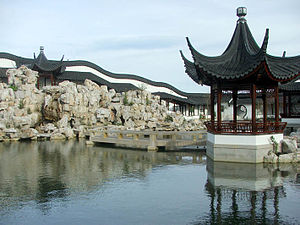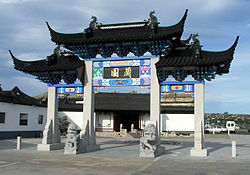- Dunedin Chinese Garden
-
The Dunedin Chinese Garden, is located in the city of Dunedin in southern New Zealand. It is sited next to the Otago Settlers' Museum close to the centre of the city and numerous other of the city's tourist attractions, including the Dunedin Railway Station and Queen's Gardens.
Contents
Name and commemoration
The garden is named Lan Yuan (蘭園). This was specifically chosen as it was considered to be significant on a number of levels. The character lan (蘭) is the third character in the Chinese name for New Zealand (niu xi lan, 紐西蘭), as well as being part of the name of the Yulan magnolia, popularly thought of as the flower of Dunedin's sister city Shanghai [Note that, by itself, 蘭 means 'orchid']. In the booklet about the garden, it is called "The Garden of Enlightenment"[1].
The garden commemorates the contribution of Chinese people to the history and culture of Dunedin. The city has long had a Chinese population, with many Cantonese people settling in and around Dunedin at the time of the Central Otago Gold Rush in the 1860s, only some 15 years after the city was founded. Over two percent of Dunedin's population is of Chinese descent.[2]
History and construction
The idea of creating a Chinese Garden in Dunedin was first raised in 1997 during preparations for the city's 150th anniversary commemorations, which were to take place the following year. As there are strong Chinese elements in the city's history, it was deemed appropriate to create such a garden. A Chinese Garden committee was formed, headed by Dr. James Ng, and a site was chosen close to the city's historic railway station and the Otago Settlers' Museum.
Initially there was some concern that the site would prove too windy, and a small but vocal part of the Dunedin population was opposed to the garden's construction. Despite these concerns, foundation stones were laid by delegates from the gardens committee and Dunedin City Council, as well as the deputy mayor of Dunedin's Chinese sister-city, Shanghai, in March 1998. Much of the cost of the project was raised by public donations, though the New Zealand Government announced in 2006 that it would support the project to the tune of NZ$3.75 million.
The garden is an authentic Chinese Garden, having been created with the support of the Dunedin City Council and the Shanghai Municipal Government. It cost $7 million to construct. The garden is New Zealand's only authentic Chinese Garden and one of only three outside China - the first of its kind to be built in the southern hemisphere.
The design of the garden evolved over the course of eight years of planning to ensure functionality, accuracy, and authenticity. The garden is in the traditional yuanlin (園林) style, and was designed by Cao Yongkang of Shanghai Jiao Tong University, Chen Ling of Tongji University, and Tan Yufeng of Shanghai Museum. They used as their basis the traditional gardens of the Jiangnan area, specifically because these gardens represent the apogee of Chinese garden style while at the same time being suitable for small sites in urban settings. [3] Construction and design was closely supervised by Shanghai Museum and architects from that city. Much of the garden was pre-fabricated in Shanghai on a site identical to that in Dunedin, then dismantled and re-assembled in New Zealand with the help of Shanghai artisans.[2]
The garden was blessed in June 2008, in the presence of Prime Minister Helen Clark and Chinese ambassador Zhang Yuanyuan and opened to the public the following month.[2] Prime Minister Clark returned to officially open the garden in September 2008.
Garden features
The Dunedin Chinese Garden is designed as a late Ming/early Qing Scholar’s garden, and is separated from the rest of the city by a four metre perimeter wall. It is centred on a large lake, around which are numerous structures: an Entrance hall, a square pavilion, a study, a climbing mountain half-pavilion and corridor, a tea house, and two-storey conference rooms. A zigzag bridge crosses the lake and connects with Chongyuan, a central pavilion. At the entrance to the garden is an elaborate Pai Lou archway.
Particular care was taken in the balance of movement and static elements, with the latter predominating . The most important vistas were to be those overlooking the central lake, with elements of movement and stasis linked by winding paths.[4]
The garden's site covers an area of some 2500 square metres, and its construction included the pouring of 560 cubic metres of concrete, the use of over 280 tonnes of sand, 130 tonnes of hand-finished granite paving stones, as well as 380,000 hand-made roof tiles, and hand-constructed bricks and lattice-work. Trees planted around the outside of the garden walls will eventually shield the garden from many of the views and noises of the city which surrounds it. Almost 1000 tonnes of rock from Lake Taihu - an important feature of Chinese architecture for over 1000 years - was imported for the construction.[5] Taihu faces environmental damage from excessive quarrying from the lake floor.[6]
References
- ^ Beattie, J. (ed.) (2008). Lan Yuan: The Garden of Enlightenment. Dunedin: Dunedin Chinese Garden Trust. p.3
- ^ a b c "Dunedin welcomes Chinese garden" (www.newzealand.com, 12 June 2008, retrieved 26 October 2008)
- ^ Beattie, J. (ed.) (2008). Lan Yuan: The garden of enlightenment. Dunedin: Dunedin Chinese Garden Trust. p.46-48
- ^ Beattie, J. (ed.) (2008). Lan Yuan: The garden of enlightenment. Dunedin: Dunedin Chinese Garden Trust. p.57
- ^ Beattie, J. (ed.) (2008). Lan Yuan: The garden of enlightenment. Dunedin: Dunedin Chinese Garden Trust. p.64
- ^ http://www.uutaihu.com/English/Sub04_6_2.htm
External links
- Dunedin City Council's Chinese Garden webpage
- Otago Daily Times article on the opening of the Garden
Coordinates: 45°52′42″S 170°30′19″E / 45.8782°S 170.5054°E
Categories:- Gardens in New Zealand
- Dunedin
- Visitor attractions in Dunedin
- Dunedin culture
Wikimedia Foundation. 2010.



